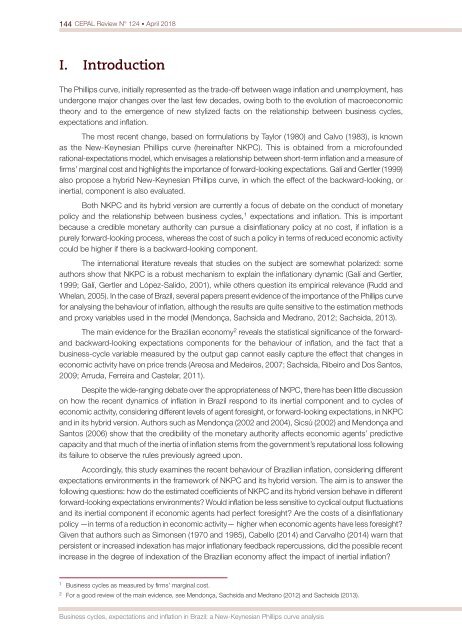CEPAL Review no. 124
April 2018
April 2018
Create successful ePaper yourself
Turn your PDF publications into a flip-book with our unique Google optimized e-Paper software.
144 <strong>CEPAL</strong> <strong>Review</strong> N° <strong>124</strong> • April 2018<br />
I. Introduction<br />
The Phillips curve, initially represented as the trade-off between wage inflation and unemployment, has<br />
undergone major changes over the last few decades, owing both to the evolution of macroeco<strong>no</strong>mic<br />
theory and to the emergence of new stylized facts on the relationship between business cycles,<br />
expectations and inflation.<br />
The most recent change, based on formulations by Taylor (1980) and Calvo (1983), is k<strong>no</strong>wn<br />
as the New-Keynesian Phillips curve (hereinafter NKPC). This is obtained from a microfounded<br />
rational-expectations model, which envisages a relationship between short-term inflation and a measure of<br />
firms’ marginal cost and highlights the importance of forward-looking expectations. Galí and Gertler (1999)<br />
also propose a hybrid New-Keynesian Phillips curve, in which the effect of the backward-looking, or<br />
inertial, component is also evaluated.<br />
Both NKPC and its hybrid version are currently a focus of debate on the conduct of monetary<br />
policy and the relationship between business cycles, 1 expectations and inflation. This is important<br />
because a credible monetary authority can pursue a disinflationary policy at <strong>no</strong> cost, if inflation is a<br />
purely forward-looking process, whereas the cost of such a policy in terms of reduced eco<strong>no</strong>mic activity<br />
could be higher if there is a backward-looking component.<br />
The international literature reveals that studies on the subject are somewhat polarized: some<br />
authors show that NKPC is a robust mechanism to explain the inflationary dynamic (Galí and Gertler,<br />
1999; Galí, Gertler and López-Salido, 2001), while others question its empirical relevance (Rudd and<br />
Whelan, 2005). In the case of Brazil, several papers present evidence of the importance of the Phillips curve<br />
for analysing the behaviour of inflation, although the results are quite sensitive to the estimation methods<br />
and proxy variables used in the model (Mendonça, Sachsida and Medra<strong>no</strong>, 2012; Sachsida, 2013).<br />
The main evidence for the Brazilian eco<strong>no</strong>my 2 reveals the statistical significance of the forwardand<br />
backward-looking expectations components for the behaviour of inflation, and the fact that a<br />
business-cycle variable measured by the output gap can<strong>no</strong>t easily capture the effect that changes in<br />
eco<strong>no</strong>mic activity have on price trends (Areosa and Medeiros, 2007; Sachsida, Ribeiro and Dos Santos,<br />
2009; Arruda, Ferreira and Castelar, 2011).<br />
Despite the wide-ranging debate over the appropriateness of NKPC, there has been little discussion<br />
on how the recent dynamics of inflation in Brazil respond to its inertial component and to cycles of<br />
eco<strong>no</strong>mic activity, considering different levels of agent foresight, or forward-looking expectations, in NKPC<br />
and in its hybrid version. Authors such as Mendonça (2002 and 2004), Sicsú (2002) and Mendonça and<br />
Santos (2006) show that the credibility of the monetary authority affects eco<strong>no</strong>mic agents’ predictive<br />
capacity and that much of the inertia of inflation stems from the government’s reputational loss following<br />
its failure to observe the rules previously agreed upon.<br />
Accordingly, this study examines the recent behaviour of Brazilian inflation, considering different<br />
expectations environments in the framework of NKPC and its hybrid version. The aim is to answer the<br />
following questions: how do the estimated coefficients of NKPC and its hybrid version behave in different<br />
forward-looking expectations environments? Would inflation be less sensitive to cyclical output fluctuations<br />
and its inertial component if eco<strong>no</strong>mic agents had perfect foresight? Are the costs of a disinflationary<br />
policy —in terms of a reduction in eco<strong>no</strong>mic activity— higher when eco<strong>no</strong>mic agents have less foresight?<br />
Given that authors such as Simonsen (1970 and 1985), Cabello (2014) and Carvalho (2014) warn that<br />
persistent or increased indexation has major inflationary feedback repercussions, did the possible recent<br />
increase in the degree of indexation of the Brazilian eco<strong>no</strong>my affect the impact of inertial inflation?<br />
1<br />
Business cycles as measured by firms’ marginal cost.<br />
2<br />
For a good review of the main evidence, see Mendonça, Sachsida and Medra<strong>no</strong> (2012) and Sachsida (2013).<br />
Business cycles, expectations and inflation in Brazil: a New-Keynesian Phillips curve analysis


















